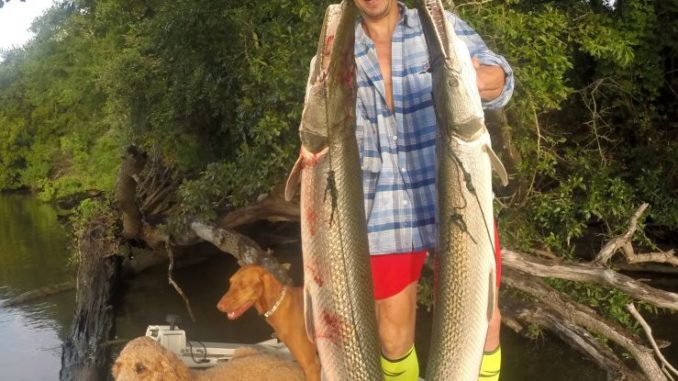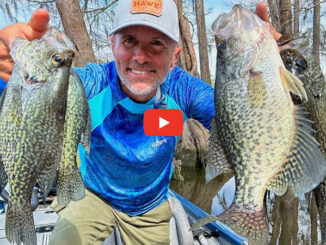
Shares favorite recipe for moist, flavorful gar patties
Homemade fish patties have long been a favorite food of mine.
Certain fish like gar and choupic are staples of my patties, but any fish will do. I have used bonito, bluefish, trout, catfish, bass, spadefish and more. I guess pretty much all fish taste great mixed in a patty, but it’s the sticky consistency of choupic and boiled down gar that work the best.
I usually hook my gar on rods and reels with unique live bait setups, special Rat-L-Traps or homemade bass creature lure setups, or I catch them by using specially-made noodle lines which I’ll discuss in a future article.
However, today I’m just describing my simple cleaning and patty-making process.
Gar are thought of as hard to clean, but in reality, they’re actually very easy. So easy, in fact, I did it in the water by the boat launch on a recent trip using nothing more than my cane knife that I won in the Cane Field Classic Machete Challenge trail race. (Usually, I take the extra step of nailing down the head to a board to allow easier chopping and cutting.)
The video shows just how easy it is to clean a gar in about five minutes, which is much less time than it takes to get the same amount of meat from dozens of smaller fish.
Start chopping behind the back fin just under the several-inch-wide flat portion of the back by chopping horizontally toward the head in a several easy whacks. Then, chop vertically downward a few times by the gills.
Finally, use the tip of the machete or a fillet knife to slice out the two huge fillets. That part is just like taking the backstrap off of a deer, and I always cut off any red meat.
Be aware that your machete will be dulled after such a skinning, but a quick sharpening will have it ready for another gar.
With the gar skeleton that remains fed to the crabs, nothing is brought home except a few gallon bags full of meat. As an added bonus, not much ice is needed to cool off the fillets compared to trying to ice down several long garfish.
When I arrive at home, I toss the fillets into a big covered pot and bring it to a slow boil for several hours, with a touch a crab boil to add some flavor. The bigger the gar, the longer it takes to get tender, but getting the meat very tender is by far the most important step.
When it is done and strained, the meat should come out looking like canned tuna in water — except I find the flavor of gar tastier than canned tuna and many other fish.
Since I’m a personal trainer who eats healthy, my patties are simple, tasty, sugar-free, low glycemic and nearly fat-free. I use plain old fashioned slow-cooked rolled oats instead of potatoes or bread crumbs.
The uncooked oats really help hold the patties together, but allow them to ‘fluff up’ when cooked, which gives a meatloaf-type of consistency. Bread crumbs, boiled potatoes or dehydrated potato flakes can be used alone or in combination with the oats.
I throw in five cups of frozen pre-chopped onions and bell pepper from the store. While cutting up fresh veggies and green onions is always tastier, the pre-made bags are quickest. The veggies give good flavor and provide plenty of moisture to the patty.
I use three cups of egg whites and let my dogs eat the yolks, but three cups of whole eggs would work as well — if more fat and cholesterol in the patties isn’t a worry. The eggs work in unison with the oats to help the patty stick together.
Also, I add in minced garlic, sriracha, salt, black and red pepper, salmon seasoning, lemon pepper, Cajun Dust seasoning, diced jalapenos, banana peppers, spicy mustard, powdered crab boil and other seasonings to taste.
Finally, I add in eight cups of boiled and drained fish meat, and mix thoroughly.
I recommend testing out a patty first before storing the entire batch to see if spices need to be adjusted. Many clients — and even my unhealthy-eating friends — all love them.
Sometimes I bake a fish version of a meatloaf lined with a 2- to 3-inch thick patty in the oven at 400 degrees for 30 minutes, and this can be eaten on potatoes and gravy.
Other methods of preparation, such as making fish balls for a meatball gravy diner over rice, or breading them in panko bread crumbs, are definite options.
However, I find the patties come out best if simply slow grilled about 5 to 10 minutes on low heat on each side, allowing the chopped onions and oats to cook up.
Then I darken each side to a golden brown on a higher heat before serving. Sometimes I eat each bit with a chunk of fresh avocado or mustard on top.
I like to make several gallons of patties at once then freeze them in quart-size bags. This way I can bring a bag or two to my camp during hunting season, and always have a tasty supper after a long day’s hunt.
Usually, I don’t measure ingredients so more of less of the eggs, oats, and fish can be used to your liking, although the amounts listed give a great consistency with any combination of fish used.
If not enough oats are used, the patties might fall apart. Using other game fish that are flaky instead of moist and mushy may also cause patties to crumble. Other small species of fish only need to be boiled or steamed for a short 10 to 30 minutes, but big fish like large catfish and gar may take hours.
So next time you catch a big gar — instead of tossing it back as a trash fish — take out the machete and find out just how delicious these prehistoric-looking beasts can be.
Just be careful not to get bit by those sharp rows of razor sharp teeth.


